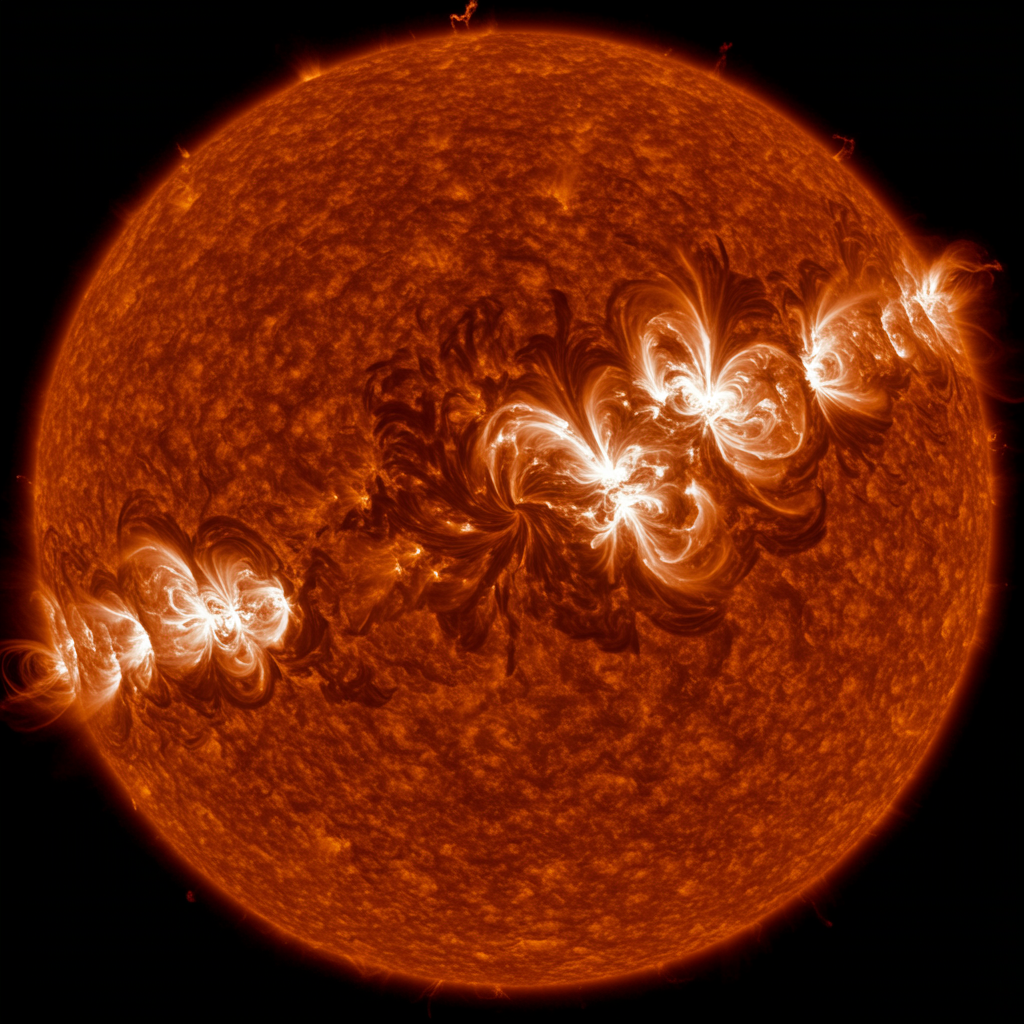Unprecedented Views: Humankind’s First Look at the Sun’s South Pole
For the first time in history, scientists have received detailed images and video of the Sun’s south pole. Captured by the European Space Agency (ESA) and NASA’s joint Solar Orbiter spacecraft, these revolutionary observations offer an unprecedented perspective on our nearest star, a region previously described as “literally terra incognita.”
Unlike previous missions and telescopes that view the Sun primarily from within the flat plane where planets orbit (the ecliptic), Solar Orbiter was specifically designed to tilt its orbit. Following complex maneuvers, including flybys past Venus, the spacecraft reached an angle of approximately 17 degrees below the solar equator in March 2025, providing a unique vantage point directly over the south pole from about 40 million miles away. This achievement marks the beginning of a “new era of solar science,” according to experts.
Decoding the Magnetic Chaos at the Pole
The initial images reveal a fascinating and complex picture. While the Sun’s atmosphere above the pole shimmers brightly, reaching temperatures of a million degrees Celsius, interspersed darker regions represent cooler gas still searingly hot at around one hundred thousand degrees.
Perhaps the most significant finding from these first views comes from the Solar Orbiter’s Polarimetric and Helioseismic Imager (PHI) instrument. It shows that the magnetic field at the south pole is currently a “messy,” “mixed-up,” or “fragmented mosaic,” displaying both north and south polarities simultaneously. This is a stark contrast to Earth’s stable, distinct magnetic poles. Scientists are particularly thrilled because this chaotic, mixed-polarity pattern was precisely what theoretical computer models predicted for the Sun’s poles during the current phase of its approximately 11-year activity cycle, known as solar maximum. Directly observing this predicted chaos confirms fundamental aspects of our understanding.
Why These Polar Views Are Crucial: Predicting Space Weather
Understanding the Sun’s magnetic poles is absolutely vital for predicting ‘space weather.’ The Sun’s entire character, from quiet periods to violent storms, is dictated by its magnetic field. This field isn’t stable like Earth’s; it constantly twists, tangles, and eventually flips polarity roughly every 11 years. This cycle is driven by the Sun’s differential rotation – its equator spins faster than its poles – which stretches and distorts the magnetic field lines.
During the chaotic phase leading up to and including the magnetic flip, the Sun releases energy through phenomena like solar flares and coronal mass ejections (CMEs). These bursts of particles and energy, channeled by the Sun’s magnetic fields, can hurtle towards Earth. Intense solar activity can disrupt satellite communications, jeopardize power grids, cause radio blackouts, and even pose risks to astronauts. While also responsible for the beautiful auroras, predicting these powerful solar storms is a major challenge.
A key hurdle in predicting solar activity has been the lack of data on how the Sun’s magnetic fields migrate towards the poles as the cycle progresses. This polar migration and reversal process is considered the “missing piece of the puzzle.” Solar Orbiter’s ability to view the poles directly allows scientists to measure the crucial fluid flows that carry magnetic fields across the Sun’s surface towards the poles, finally providing the data needed to improve predictive models.
Instruments Revealing Hidden Secrets
Beyond imaging the magnetic field, Solar Orbiter’s instruments are providing unprecedented detail about the Sun’s atmosphere and composition. The Extreme Ultraviolet Imager (EUI) shows the million-degree coronal gas, while the Spectral Imaging of the Coronal Environment (SPICE) instrument analyzes light emitted by specific chemical elements like hydrogen, carbon, oxygen, neon, and magnesium at different temperatures.
Crucially, the SPICE team has achieved another first: using Doppler measurements of these spectral lines to track the speed and movement of solar material. By seeing how fast clumps of gas are flowing, especially from this new high-latitude perspective, scientists gain revolutionary insights into how particles are propelled outwards from the Sun to form the solar wind. Previous measurements from the ecliptic plane were hindered by the oblique view, making these new polar flow measurements game-changers in understanding solar wind origin.
The “Holy Grail” of Solar Physics
The ultimate goal of studying the Sun’s poles and magnetic dynamics in such detail is to develop highly accurate computer models capable of forecasting space weather events. Accurate predictions would allow satellite operators, power companies, and even aurora enthusiasts to better prepare for potentially disruptive solar storms. Achieving this predictive capability is often referred to as the “Holy Grail of solar physics.”
While Solar Orbiter’s initial views are a monumental step, confirming theoretical models and providing vital data where none existed before, scientists note that more work is needed before we can reliably predict Earth-bound eruptions based on signals from the Sun’s poles.
This mission builds upon previous efforts like the Ulysses probe (1990-2009), which also flew over the poles but lacked imaging capabilities. Solar Orbiter uniquely combines close-up imaging with a suite of instruments to study both the visible features and the particles/fields around the Sun.
These initial views are just the beginning. Solar Orbiter will continue to increase its orbital tilt in the coming years, promising even better perspectives on the Sun’s poles that will further transform our understanding of its magnetic field, the solar cycle, and the space weather that impacts our world.
References
- www.bbc.com
- www.scientificamerican.com
- <a href="https://www.esa.int/ScienceExploration/SpaceScience/SolarOrbiter/SolarOrbitergetsworld-firstviewsoftheSunspoles”>www.esa.int
- www.theguardian.com
- www.firstpost.com




